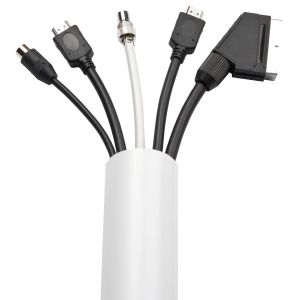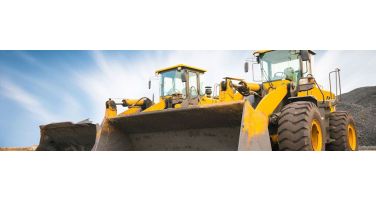You will no doubt have noticed the white, boxed tubing that runs around the walls and floor of your office building, and possibly wondered what it was for, apart from tidying away all the cables, such as network cabling, running to all the PCs.
This plastic, hollow tubing is called cable trunking and it actually has various uses.
This article will talk you through those uses and also highlight that, beyond its utility in an office environment, cable trunking can also be extremely useful in the domestic setting, where it might possibly prevent serious dangers such as electric shock, and electrical fires.
A key use of cable trunking is indeed to keep your cabling tidy and hidden way. The tough white plastic hollow casing of the cable trunk is used in cable management, organising all the cabling you have running about the workplace. Of course, one function of this is aesthetic, in terms of keeping everything tidy and in one place, and associated with this, of course, is the health and safety benefits inherent in preventing staff members from tripping over random cabling running about the office. In terms of management, the trunking also includes hinged sections that might be opened, or completely removed, allowing technicians to repair, inspect or indeed replace cabling where there have been issues.
A further and perhaps more fundamental function of cable trunking is the protection and safeguarding of people you love and those under your duty of care. The plastic boxing prevents the wires being exposed to any water hazards and ingress - for example, accidental floods while the office is unoccupied – preventing electrical fires and electric shocks.
Smaller leads and wires can also be kept contained using Cable Tidy Units. These are perfect for desks, in particular, ensuring all cables are out of the way whilst working.
These benefits also carry over into the family home. With the greater proliferation of electronic devices, including TVs, hi-fis, cable TV and computer games consoles, you may well feel that the associated cables are already becoming a real hazard in your home. Here at Hilltop, we will gladly talk you through the many benefits of using cable trunking to safely store the cabling in your own property.
Benefits Of Cable Trunking
There are several benefits to using cable trunking at home and in the office.
Replace all those extension cords
With so many appliances to run, you may have found yourself ‘daisy-chaining’, or running one extension from another. Extension cables can look sturdy, and of course, some include surge protectors, but if they are exposed on the floor, they are likely to be stood on, in which case the cable insulation may become damaged and the electrical resistance compromised. Of course, if your cables are in one ungodly tangle, they can heat up, or rub against one another and ultimately fray, causing a fire risk. And don’t feel you can sweep your cables under the carpet or rug – in those situations, they can also heat up and become dangerous.
This, therefore, is not ideal, and you will be better served by installing dedicated main sockets and using cable trunking to run the electric cabling around the room – perhaps concealed as part of the ceiling, to the relevant devices. Then, instead of you having to get behind the TV to try and figure out what goes where, cable trunking will ergonomically separate the cables, with plenty of air to keep them cool. This looks tidier and is also much safer in terms of electricity use.
Free up plug sockets
If you are running adaptor plugs upon adapter plugs you are causing potential electrical issues in the home. If you also are running something akin to an Amazon forest of Amazon-purchased electrics from your plug sockets, you are also risking cables bunching up, and also getting pulled about, with sockets that were once stiff, now loose with all the constant unplugging and plugging.
Instead, group your cables together, and run them around the home using cable trunking, to relieve the stress on the plug sockets and the need for the constant switching of plugs for different devices. In terms of safety, if there ever is a spark in the cabling, that will also safely extinguish against the plastic of the trunking, instead of potentially jumping out onto carpets or furniture.
Appliances
The home is different from the office in that you’re likely to have different devices running. Each of these provides varying issues when it comes to electrics, wiring and safety. The fridge, for instance, provides a particular hazard in that the cabling is probably out of the way, and therefore liable to gather dust or – dare we say it - provide a snack for an uninvited furry friend. Fridges use flammable gasses and protection is particularly key. Likewise, the wiring of microwave ovens is also often concealed, and as we know, they can get incredibly hot, while the movement of washing machines in a cycle can also mean that they move in ways you don’t expect.
Moving into the living room, modern TVs are now highly evolved in their electronics, but that doesn’t include Dad behind the thing, fiddling with wires, moving the TV about, and bringing the wires into contact with one another. And lighting itself can also be an issue, with the wiring for lamps running around the room. In all these cases, using cable trunking tidies and protects the wiring, while providing room for the cables to move, without rubbing up against one another.
ALL USEFUL ADVICE, WE HOPE, IN TERMS OF CONSIDERING CABLE TRUNKING FOR BOTH THE OFFICE AND THE HOME. IF YOU HAVE ANY FURTHER QUESTIONS ABOUT CABLE MANAGEMENT SOLUTIONS, PLEASE FEEL FREE TO CONTACT US HERE AT HILLTOP. CALL: 01942 723 101.






